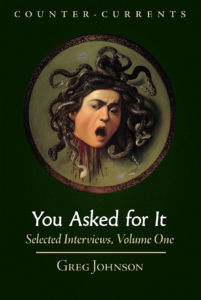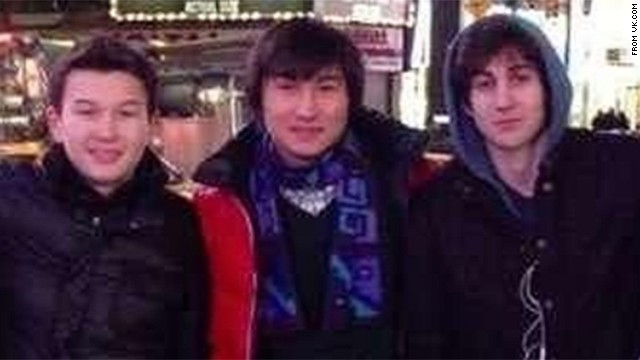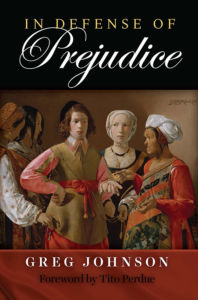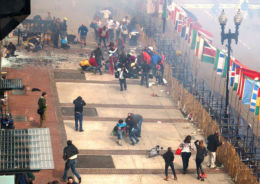The Boston Marathon Bombing
Ethiopian Lelisa Desisa Benti was the fastest runner in the 2013 Boston Marathon. The fastest woman was a Kenyan who finished 16 minutes behind him. Nobody, however, remembers the victors in Beantown’s 2013 race. What the public instead remembers is the catastrophic act of terror perpetrated by two Chechen Muslim refugees.
The Boston Marathon is always run on Patriot’s Day, the third Monday in April. Patriot’s Day commemorates the April 19, 1775 battles of Lexington and Concord that marked the beginning of the American Revolution. In the more than two centuries since, April 19 has become a red-letter day in America — a day made red with blood. The first blood spilled during the Civil War occurred on April 19, 1861 in Baltimore. The FBI burned most of a group of Branch Davidians to death in Waco on April 19, 1993. Two years later to the day, a Gulf War veteran, Timothy McVeigh, blew up the Federal Building in Oklahoma City in response. April 19 is therefore as much a cursed day in American history as a celebration of its founding patriots. Strictly speaking, the Boston Marathon Bombing of 2013 was not on April 19, it was on April 15, but the holiday was meant to celebrate the events of April 19, 1775.
The first bomb exploded at 2:49 PM, approximately five hours into the race, on the north side of Boylston Street, near the finish line. The second exploded moments later near a restaurant called Forum, which was also on the north side of Boylston Street. Three were killed in the explosions, two Americans and a Chinese woman, and 281 were injured, some quite seriously, including lost limbs. The attacks took place in an area that was filled with closed-circuit cameras as well as reporters and bystanders, many of whom were filming the event.
No group immediately took credit for the attack. As a result, there was much speculation in the first hours that followed. The date being so close to the 19th created suspicions that the perpetrators might have been old-stock Americans carrying out an attack for “radical Right-wing” motives.
After investigators scoured the crime scene, they concluded that the bombs had been pressure cookers filled with gunpowder. They were similar to improvised explosive devices (IEDs) that are common in the Islamic world. The police then had a possible motive.
The investigators had huge amounts of data to sort through, and for hours after the bombings there were no genuine leads. False leads abounded however. The New York Post ran a cover story showing two Middle Eastern-looking men who had been photographed carrying bags at the scene. It turned out they had not been involved, however. Another man at the scene, a Saudi, had behaved very suspiciously after the bombing and was held in custody until he was cleared. Some even turned in photoshopped photos, which ended up wasting the police’s time and resources.
A Reddit page was set up where photos of the attacks were released to the public in the hope that someone would come forward with useful information. I myself poured over them. Any bearded, Muslim-looking men were immediately regarded with suspicion. An entire thread was devoted to following the actions of one such man until more photos were uploaded and it became clear that he was in fact one of the injured victims.

You can buy Greg Johnson’s You Asked for It here
I’ll trace what the investigators must have done in what follows.
The police were able to determine that the two bombs had gone off on the same side of the street, indicating the likely path of the bomber or bombers. Then, they needed to figure out whether or not it had been a suicide bombing, and thus whether the terrorists were still at large or not. Once that was known, the investigators had to determine exactly where and when the blasts had taken place and find video of the scene during the seconds prior to the explosions. Armed with that data, they then would have had to identify each of those killed and injured, as well as the other bystanders in order to determine who had left the scene just prior to the explosions.
Many gruesome photos of those killed and injured were released to the press. It was an appalling horror. Investigators knew that the perpetrators were likely among the crowds that had been photographed and filmed, but they had no idea who they were looking for. The break in the case finally came from two sources. The first was from Jeffrey Bauman, who had lost part of both his legs. While being interviewed in the hospital, he revealed that he had seen one of the bombers — who turned out to be Tamerlan Tsarnaev — put a bag containing one of the explosives down at the finish line. Another bystander turned in a photo of Dzhokhar Tsarnaev, who was shown wearing a white hat backwards while walking away just before the second explosion.
With these breaks, investigators were finally able to trace the terrorists’ movements. Once they’d identified Dzhokhar, who had planted the second bomb, in the photographs, they reviewed the closed-circuit videos that had been taken along the street and traced Dzhokhar’s movements prior to the explosion. This was when they discovered that Dzhokhar had been working with someone else: his brother Tarmerlan. Video showed the pair as they rounded the corner onto Boylston Street. Both were wearing backpacks as they approached, although Dzhokhar wasn’t wearing one when he left. Tamerlan apparently left the scene without being filmed. It is likely that investigators took their photos of the Tsarnaevs to eyewitnesses for additional confirmation.
Facial recognition software was not yet advanced enough in 2013 to identify both men from the grainy photos they had. The question then arose as to whether to release the photos of the suspects to the public or not. On the one hand, the police could have identified the men secretly and then arrested them at their home by surprise, thus dispensing with the need for a manhunt and potential shootout. On the other, if they released the photos it was expected that they would quickly learn the suspects’ identities via a tip. The down side of this approach was that the suspects themselves would know they had been identified and could make a run for it, and also prepare for further violence. Nobody on the investigation team seems to have given a thought to working with those who were sleuthing on the Internet, which could have been a middle way between the two approaches.
The impasse was broken when photos of the suspects were leaked to the press, forcing the police’s hand – although the media announced the time when they would go public with them. This ultimately ended up being the best approach, however, as there had been no way for the police to identify the suspects in secret.
The Tsarnaev brothers got away from the scene of the bombing nearly perfectly. Dzhokhar even went shopping at a Whole Foods market afterwards, as though he were picking up snacks after a hard day’s work. He also sent out several tweets.
When the photos were released, no tips came in. Those who knew the pair couldn’t believe what they were seeing, so they twisted the evidence in their own minds: a nose was too long, the hair was too curly, and so on. Also, given that the Tsarnaevs were Muslims, their community didn’t want to bring further hostility upon themselves. The Tsarnaevs didn’t even realize that they were suspects until two of Dzhokhar’s Russian-speaking Kazakh university friends tipped him off.
In the end, however, the police did not get their names from the public. It was not until they ran Tamerlan’s prints and identified them that they got a positive identification.

Dzhokhar Tsarnaev with Kazakh friends. The Tsarnaevs were protected by Boston’s diverse community. Muslims who knew them didn’t phone in any tips.
It has been reported that the Tsarnaevs had a dubious plan to travel to Manhattan and continue their jihadist rampage after they were outed. On the evening of April 18, 2013, shortly after their photos were released, they murdered an MIT campus policeman and attempted to steal his firearm, but his holster was equipped with a security device that made this impossible. The pair then kidnapped a Chinese student and stole his car. The carjacking victim eventually escaped and called the police emergency number. He gave them his car’s GPS tracking number, which they then used that to locate the car in Watertown, where a shootout ensued. The two Chechens fought wildly, continuing to return fire and throw bombs even after being wounded. Dzhokhar managed to return to the stolen car and escaped, running over Tamerlan in the process and mortally wounding him, mistakenly believing that he was a wounded police officer. Sixteen police were injured in the shootout, one of whom died of his injuries a year later.
Dzhokhar then ditched the car and hid out in a winterized boat. All of the Boston area went into lockdown. Police combed Watertown, even searching back yards and trash bins without search warrants. The lockdown eventually ended — but an ordinary citizen who had gone outside for a cigarette in Watertown noticed Dzhokhar in the boat. He called the police, a second shootout followed, and Dzhokhar finally surrendered after hearing an appeal to do so from his high school wrestling coach.

You can buy Greg Johnson’s In Defense of Prejudice here
Dzhokhar was convicted for his crimes and sentenced to death. His sentence remains on appeal. It is important to note that although the FBI was involved, it ended up being local law enforcement and ordinary civilians who did the dangerous front-line work of bringing the bombers to justice.
The Tsarnaevs were white. Chechens are, by definition, as Caucasian as a people can possibly be, given that Chechnya is in the North Caucasus. But their Islamic faith and long history as part of the Russian Empire makes them as remote and foreign to the ethnic American Majority as any other non-white people.
When whites — especially white Americans — realize they are under attack by non-whites, it often becomes clear in retrospect that the war had already been ongoing for some time before it was widely noticed.
When looking back at the years prior to the Dakota Sioux attack on whites in Minnesota in 1862, one can see that the Sioux had been at war with whites since 1857, when a group called the Wahpukute renegades began murdering whites in Iowa.
In the case of the Tsarnaev brothers, it is likely that Tamerlan had spilled blood prior to the 2013 attack. While not proven in court, it is quite possible that he and another Chechen Muslim named Ibragim Todashev murdered three Jewish men on September 11, 2011. The victims’ throats were slashed and their heads were pulled back in the manner of Chechen beheading videos that had been online since the late 1990s. Marijuana was also dumped over their bodies.
It’s possible Tamerlan went to war before anyone else noticed.
As a coda to this story, shortly after the Boston Marathon Bombing, one of the Tsarnaev sisters was herself arrested for threatening to bomb a romantic rival.
It would have better for everyone had the Tsarnaevs remained in Chechnya.
The Tsarnaev family had originally come to the United States in the 1990s as a result of the Chechen War that was being fought with Russia. Thus, to the US government they were “refugees” fleeing “persecution.” But the Tsarnaevs hadn’t been in Chechnya during the war; they were living in Kirgizstan. And in fact, the Tsarnaev’s parents ended up getting divorced after the bombings — and then moved back to Russia. Americans should end any support for refugee resettlement as a matter of self-preservation.
Fortunately, America’s institutions responded appropriately to the Boston Marathon Bombing. But unfortunately, the ecosystem of madness which had allowed the attack to occur in the first place ultimately prevailed. Barack Obama, who was President at the time, was part of this ecosystem. He was elevated to the presidency in no small measure due to the “civil rights” narrative which underpins the 1964 Civil Rights Act. This narrative has led to the idea that whites are inherently “racist” and that anything they do in their own interests is merely an expression of racism. It was this belief that made it possible for any skepticism of the wisdom of importing Muslims into the United States, even after previous terrorist attacks perpetrated by them, to be dismissed by the establishment.
This became even clearer after President Obama played stupid — that’s the only way to describe it — when, in 2015, a Muslim student of immigrant background fashioned a clock to appear like a bomb and brought it to school as a prank. The school took the incident seriously and disciplined the student, but it was then criticized for “Islamophobia” — despite the fact that many terror attacks had been carried out by Muslims in the US in the years prior. White liberals had become anti-anti-Islam, in the same way that they had been anti-anti-Communists during the Cold War.
There are some unsolved mysteries that remain surrounding the bombing. For one, then-FBI Director Robert Mueller personally authorized his agents to search Dzhokhar’s college dorm without a warrant. Additionally, Tamerlan’s associate, Ibragim Todashev, died in May 2013 while in FBI custody as he was being questioned about the murders of Jews on September 11, 2001, allegedly because he attacked the officers who were holding him. These events were highly unusual.
Looking back, the Boston Marathon Bombing was perhaps the last moment of sanity in America. Americans saw an enemy and correctly recognized who and what they were, and properly celebrated their heroes. Since then the wounds may have been healed and the dead may have been buried, but American society has descended into a state of collective dementia.
* * *
Like all journals of dissident ideas, Counter-Currents depends on the support of readers like you. Help us compete with the censors of the Left and the violent accelerationists of the Right with a donation today. (The easiest way to help is with an e-check donation. All you need is your checkbook.)
For other ways to donate, click here.




